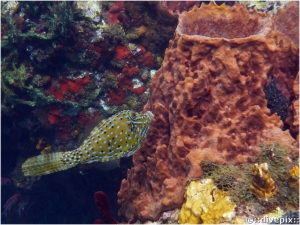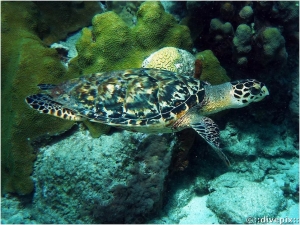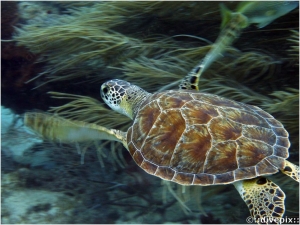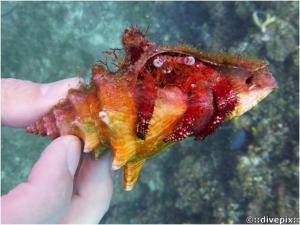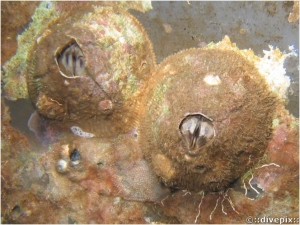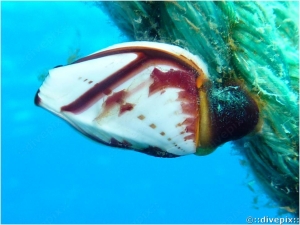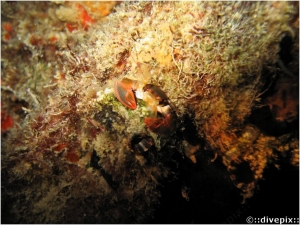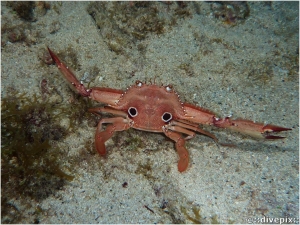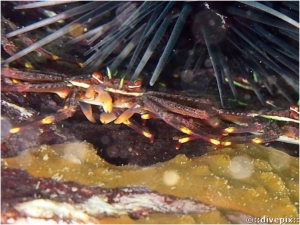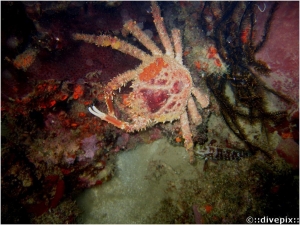




Eric H. Biass
lundi, 28 janvier 2013 19:46
Giant Barrel Sponge
| Aspect: | Light to dark brown, generally large to very large, sturdy barrel-shaped structure. A favourite staple for Hawkbill Turtles (q.v.) as shown by some of the pictures herewith. Also see the devouring action in the Hawkbill Turtles entry. |
| Population: | Ubiquitous |
| Notable feature: | Thick, hard leathery skin, outer surface can incorporate either deep linear vertical valleys and sharp-edge mounds or rounded mounds and dimples as seen on the photos herewith. |
| Environment: | Open waters |
| Behaviour: | - |
Publié dans
Eponges
Tags:
samedi, 26 janvier 2013 19:18
Hawksbill Turtle
| Aspect: | Oval flying saucer-like carapace, with relatively rough dark upper plates. The carapace is bordered by a number of smaller plates forming a relatively rough edge. |
| Population: | Now abundant, after near extinction in the early 1990s. Given the size of one of the specimens seen on some of the pictures below, they now seem to breed around Ilets Pigeon. |
| Notable feature: | Compared to the Green turtle, it has a very hawk-like upper beak, hence its name. See top left picture below for subtle differences with Green Turtle |
| Environment: | Usually found in open waters, down to 40 metres, often close to the botton in search of food (sponges are a favourite) but also close to rocky shores. |
| Behaviour: | Always an imperssive sight. Will suddenly soar to the surface to take a deep breath and dive straight back down to where it started, either to finish a meal or simply go back to sleep, often wedging itself under a rock ledge. |
Publié dans
Tortues
Tags:
mardi, 22 janvier 2013 19:47
Green Turtle
| Aspect: | Oval flying saucer-like carapace, with relatively smooth light brown upper plates. The carapace is bordered by a number of smaller plates forming a relatively rough edge. |
| Population: | Now abundant, after near extinction in the early 1990s. |
| Notable feature: | Compared to the Hawsbill turtle, it has blunt upper beak. See top left picture (below) for subtle differences with Hawksbill Turtle. Often the unwilling transport of Remoras and Sharksuckers. |
| Environment: | Found in open waters, but more often in alga and grass-covered sea-bottoms in sheltered bays where they can be seen grazing. Unlike the Hawksbill turtle, it essentially is herbivore. |
| Behaviour: | Always a sweet sight, will not be too bothered by a quiet, non aggressive swimmer, but is more wary than the generally larger Hawksbill Turtle. |
Publié dans
Tortues
Tags:
jeudi, 17 janvier 2013 23:56
Blue-eye Hermit
| Aspect: | Red overall, but with white dots on the forward end of its limbs. Red antennae and antennules. |
| Population: | Regularly abundant. |
| Notable feature: | Blue eyes at the tip of red or pink stalks. |
| Environment: | Sandy bottoms. |
| Behaviour: | Retracts when approached too closely, but will then slowly pull out again. |
Publié dans
Pagures
Tags:
jeudi, 17 janvier 2013 23:43
Goose-neck Barnacle
| Aspect: | White elongated shell (up to 4 cm tall) with small brown markings from which emerge brown cirri (tentacles) used by the animal to catch its small preys. They affix to almost any semi-submerged objects thanks to a stalk of dark, grainy appearance. |
| Population: | Very common throughout the world. |
| Notable feature: | Lepas are often mistaken for whitish mussels at first sight, but in fact are neither bivalves nor molluscs, but crustaceans in their own right. A hermaphrodite, it will survive in cold waters but will not reproduce in such environments |
| Environment: | Attach to any stray flotsam, metal and plastic boat hulls, ropes, mooring line, etc, in many seas of the world. Specimens attached to an aileron section believed to belong to flight MH370 will thus be of little help to identify the course followed by the part from its point of impact to a Reunion beach. |
| Behaviour: | Will retract into its shell if approached too aggressively. |
Publié dans
Bernacles
Tags:
jeudi, 17 janvier 2013 23:20
Ocellate Swimming Crab
| Aspect: |
Very flat red body featuring two dots on its upper surface. The animal is deceptively small. |
| Population: | Common. |
| Notable feature: | The two darker dots on the rear part of the carapace attempt to replicate a pair of eyes (hence "ocellate"). Rear paddled legs help it swim. |
| Environment: | Usually found around rocks and small galleries |
| Behaviour: | Particularly visible at night, but will retreat into the first availlable cache if approached too briskly. |
Publié dans
Crabes
Tags:
jeudi, 17 janvier 2013 22:58
Hairy Clinging Crab
| Aspect: | Carapace and limbs are red, orange or dark red, and covered in spines that gather all manner of matter giving a hairy appearance. Body can reach a diameter of about 13 cm. |
| Population: | Common, but really visible at night. |
| Notable feature: | The two front arms are tipped with narrow blunt white claws preceded by a narrow brown "sleeve" (which contrast with the much broader appendice of the Channel Clinging Crab (q.v.). |
| Environment: | Rocky surroundings, small caves and under overhangs. |
| Behaviour: | Will back into a recess if approached too closely. |
Publié dans
Crabes
Tags:



